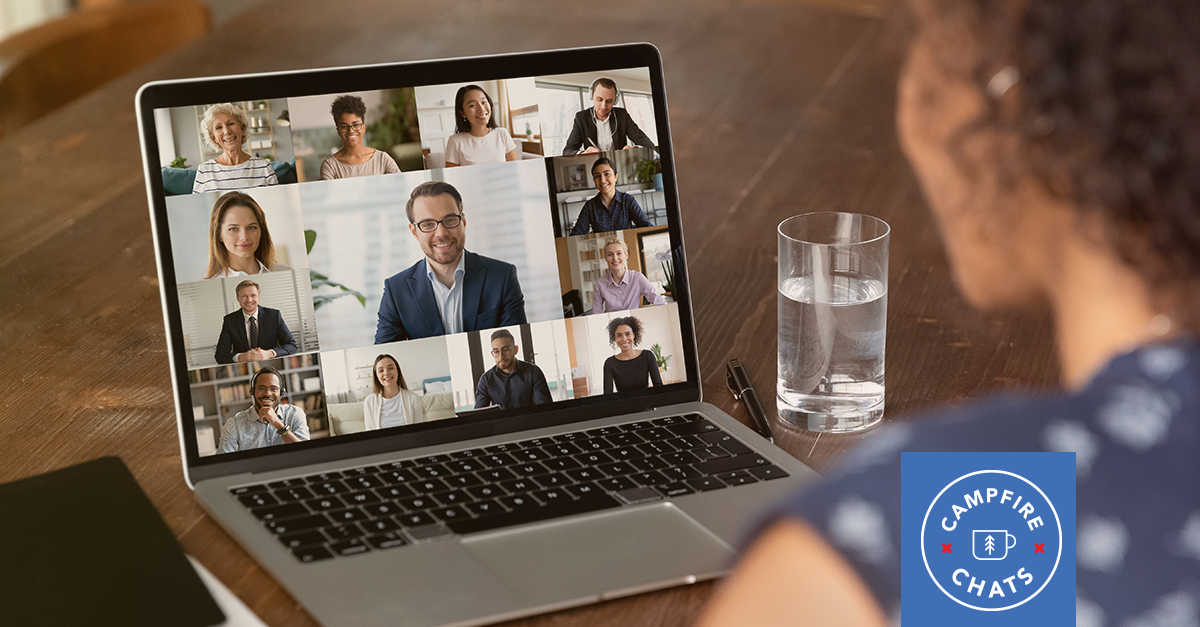On February 24, 2022, we hosted a campfire dedicated to B2B healthcare marketing: the trends, best practices, what buyers want, changes in buying journeys, and predictions about the future of in-person conferences and presentations. Special thanks to our rockstar panelists for 45 minutes of rapid-fire insights: Sarah Bennight, Lexi Dingman, Chris Hemphill, and Burt Rosen. Make sure to follow them on LinkedIn!
What are the trends, marketing and selling to and for healthcare brands?
Let’s start by reflecting on trends impacting our buyers’ organizations: patients, customers and end users of their products and services. After all, the people whom we seek to serve (buyers of B2B solutions) want solutions that help them to serve their audiences: referring providers, patients, and other clients and customers.
The pandemic sped up a long-term trend: we now live in an on-demand world.
Consumers want it NOW. They don’t want to wait for healthcare. They don’t want to wait to be seen, treated, and healed.
How do your products and services solve for the end user’s expectations? Are you packaging and presenting your solutions in a way that resonates with what your B2B audiences need to deliver to their consumers and end users?
This on-demand mentality transcends traditional consumers. It’s true of the audiences you are marketing and selling to within healthcare organizations. Your B2B audiences are experiencing major work demands:
- Shorter deadlines
- Higher stress
- Need to solve problems at a faster pace than ever before
How do your products and services solve for your B2B buyers’ personal and professional needs?
At Hailey Sault, we find these top the personal and professional needs of our B2B buying audiences:
- Data clarity: a clear map of performance mapped back to business growth
- Agility: flexibility with solutions and speed of delivery
- Voice of Consumer: deep knowledge of the desires, preferences and behaviors of end user consumers
FILLING THE TOP OF THE SALES FUNNEL
During our webinar, we talked about the recent trend many of us are experiencing in B2B marketing: filling the top of the sales funnel.
Throughout the pandemic, vendor contracting and exploration of new vendor selection was often put on hold or delayed to deal with other pressing matters (such as dealing with COVID-19 responses). That meant many B2B marketing efforts were spent nurturing late-stage opportunities and expanding existing relationships.
As we approach the pandemic’s two-year mark, the sense from the panelists is that we’re reaching a new inflection point: filling the early-stage prospect funnels again.
How are you driving new leads and engaging qualified prospects to grow the top of the marketing lead-generation funnel?
Here are a few suggestions from the Hailey Sault playbook:
- Focus on “Value Per Minute” with your content. Chris Hemphill is involved in the AI technology for his company and produces many of the firm’s education-based webinars, videos, and podcasts. He shared that his firm’s long-form videos often receive more engagement than shorter, “byte-sized” clips. How can you increase the overall value of your content to your B2B buying audiences?
- Expand your digital footprint. Go beyond traditional B2B marketing channels like LinkedIn and email marketing and invest in programmatic advertising buys that reach your audiences as they consume content generally—not just when they have their “work hats” on.
- Make it personal. Personalized marketing can be as sophisticated or as simple as you have the resources to allow. Regardless of what’s available to you, aim for personalizing your marketing outreach: content and resources that are honed to the exact needs of your audiences; experiences on your digital platforms that resonate; and creating enough insight with your data so that you can make intentional, informed decisions about the next opportunity to create engaging impact with your B2B audiences.
What are organizations, decision-makers and other B2B stakeholders asking for these days?
Of course, B2B buyers are asking for what they’ve always asked for: better service, better results, and better cost structures. In our On-Demand World, buyers want speed, precision, reliability, and performance. To the extent that your organization can deliver on those expectations, your ability to market and sell is greatly improved.
But we asked the panelists to take a step back and reflect on what they’re hearing from their B2B clients, and the conversations they’re having in presentations with stakeholders.
Sarah Bennight was the first to bring up that healthcare companies are looking for vendor partners who are aligned on mission, purpose, values and social change. Since the pandemic, America has seen a great awakening of social causes and the desire to impact positive change.
How is your organization communicating its leadership in driving positive social change?
In Hailey Sault’s 2022 Healthcare Marketing Trends Report, we write about the trend of “Return to Purpose”: organizations realigning around shared values and casting vision for better days ahead, and how organizations are coalescing around these important messages and actions.
Communicate in your marketing and sales materials how your organization is a great corporate partner to your clients. Align with a common mission and shared purpose, and how your organization is going beyond the bottom line to impact positive change.
B2B buying audiences are also asking for more insights on how to better serve their clients, customers and end users of their products and services.
Remembering that your B2B audiences are busy and stressed out, they’ll find value if your marketing can help them better understand their desired audiences. After all, a “value bomb” in your marketing content, that your prospect reads then shares in a business meeting to the compliments of her boss and team, is a large step forward in solidifying a business relationship.
Burt Rosen also cautioned against having a too-assertive sales mindset. He recounted stories of coaching sales teams to enter presentations with the mantra, “How can I help you today?” versus “How can I sell you today?” In fact, Burt shared that in his experience leading B2B marketing efforts for multiple companies, the least important section of a presentation deck is the “About Us” section. Instead, begin presentations with how your organization can solve your prospects’ challenges.
How have B2B buyer journeys changed since the pandemic?
Lexi Dingman supports a leading children’s hospital sales outreach program with marketing strategies and data insights. Her sales team misses the face-to-face interaction with referring providers. These “heart to heart” moments are essential to strong relationships, which is key to great sales engagement. In lieu of having these face-to-face moments, Lexi is driving more insights to the sales and outreach team, sharing how providers are engaging with content and resources, and creating new tools to bring value to provider sources.
The other panelists involved in C-suite marketing and sales agreed that not having to fly and travel to present to every prospect has been a good thing. B2B buyers aren’t expecting (or encouraging) in-person meetings. But the flip side is that it’s much harder to build deeper relationships via Microsoft Teams or Zoom.
Because of that, marketers and salespeople must avoid the risk of “transactional status”: being perceived as just another vendor in a sea of many. B2B marketers can support sales in finding new ways to bring value to key relationships: through consumer and marketplace insights, and providing data that indicate the unaddressed needs of B2B buyers.
In our B2B practice with clients, we’ve observed that B2B buyers are waiting longer and longer to initiate first contact with vendors for product/service information and demos. There are two ripple effects of this trend:
1. B2B buyers are making more of the buying decision without benefit of vendor engagement. This limits vendor organizations’ ability to influence the buying decision.
2. B2B buyer timelines for contracting and deployment of new solutions are tighter and less flexible. These shrunken timelines are a product of the “On-Demand World” we live in, and are also due to the challenges organizations are experiencing in aligning stakeholders, many of whom are still working remotely. The lag time in building internal consensus means a reduction on the vendor’s end for deployment once the contract is signed.
WHAT’S NEXT FOR B2B MARKETERS?
As one of the panelists shared, we’re in a period of unprecedented creativity. We have access to data, tools and deployment strategies the likes of which we’ve never seen before. We’re also seeing an incredible trend: salespeople are leaning into their marketing counterparts like never before. This is likely due to salespeople not having their “traditional” access to face-to-face meetings and presentation demos with buyers, along with the next generation of salespeople who are digital natives and see the benefit of digital marketing to enhance and encourage high quality sales conversations.
As we find our footing in what feels like (as of late February 2022) a turning point of the pandemic, we think it’s an exciting and engaging time to be B2B healthcare marketers. End users and consumers of our B2B clients are tuned into their health like never before, and are demanding healthcare brands step up and deliver. Our B2B buyers have growing challenges, which encourages reviewing the vendor landscape with a fresh lens to see who can service those challenges. These trends are ripe opportunities for B2B marketers.
How will you leverage this time?



